



Livestock Resources and Environmental Issues in Asia
Livestock production is a significant and growing source of nitrogen and phosphorus pollution, range degradation and greenhouse gases, according to Benjamin Henderson (Livestock Policy Officer) and Henning Steinfeld (Chief of Livestock Information and Policy Branch), both with the FAO in Rome. They also identify possible solutions to these problems.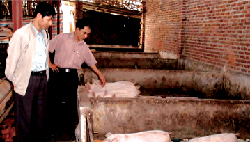
Asia has experienced dramatic increases in the production and consumption of livestock products in recent decades, according to the authors, whose paper was published in an FAO report, 'Asian livestock: Challenges, opportunities and the response', the proceedings of an international policy forum held in Bangkok, Thailand in August 2012.
As shown in Table 1, the production of milk and meat in East Asia proceeded at a faster pace for both meat and milk compared with other Asian regions, and compared to developing countries as a whole, between 1991 and 2007 South Asia has also experienced fast growth in the production and consumption of dairy products over this period.
The rapid rate of growth for meat and dairy products in East Asia is attributable mainly
to China, which has had the fastest growth in the production and consumption of all major
livestock products, due mainly to very rapid per capita income growth and associated
diversification away from food staples towards animal products (Pingali and McCullough
2010).

Source: Adapted from data used in FAO (2011a).
Growth in the production and consumption of both meat and milk is projected to slow quite considerably in East Asia from 2005/2007 to 2030, due to a combination of slower population growth and already quite high per-capita consumption rates in places such as China, which increased from 14kg per year in the early 1970s to 52kg presently (FAO 2011a). While milk production and consumption is also projected to decline in South Asia, an acceleration in meat production and consumption could occur mainly due to the region's continued participation in the global upsurge in poultry production (FAO 2011a). As shown in Table 2, poultry growth rates in South Asia have matched those in East Asia in recent years, and they are projected to continue at a similar pace until 2030.
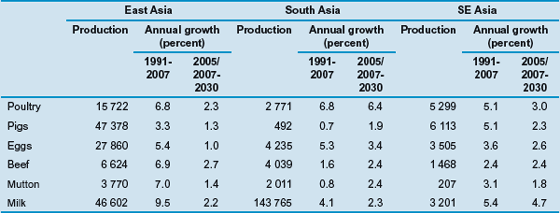
Source: Adapted from data used in FAO (2011a).
It is possible that India will assume a large global growth role in future given its massive population and current low level of meat consumption (3.1kg per capita), but it is unlikely to have an impact on global and regional averages exerted historically by China (FAO 2011a). Despite the slowdown in consumption, a slower growth rate applied to a large base level in China will still produce large absolute increases in production – accentuating resource constraints and environmental problems that are already associated with such large livestock sectors in the Asian region.
Structural Changes
On the supply side, technology has been the most important factor behind the rapid growth in livestock output, with the introduction of higher-productivity breeds, new feeding systems and rearing facilities all playing a role in improving production efficiency (Bingsheng 2010). This has been accompanied by a rapid expansion in large intensive livestock systems,
which is characterized by a shift from ruminants to pig and poultry and agglomeration near
urban market centres (Menzi et al. 2010). These changes are particularly evident in East
Asia and Southeast Asia, which are now worldwide pig and poultry producers.
As the share of industrial-scale production has expanded relative to backyard pig and
poultry production, as well as ruminant production, an ever-increasing amount of cereals
is being channelled to the livestock sector. While the percentage of cropland for livestock
production is much higher in Europe and the Americas (50 to 60 per cent) versus Asia (20
per cent), this proportion is ratcheting up in Asia. For example, of the 11 million tonnes of
maize produced in India, 5.0 million tonnes are used in poultry (Chacko et al. 2010). In some
cases, these demands can be met locally, but with limited scope for expanding cultivated
land, Asian countries are increasingly turning to imports to meet their livestock feed needs.
For instance, grain production in China stagnated over the 1996-2007 period, even though meat production increased by 50 per cent. This growth was partly accommodated through gains in feed conversion efficiency, but also through a dramatic increase in import of feed
commodities, soybeans in particular. Chinese imports as a share of global soybean exports,
increased from just one per cent in 1995 to 42 per cent by 1995 (Bingsheng 2010).
Natural Resource and Environmental Issues
One of the consequences of historical and recent rapid growth of livestock consumption and production is the emergence and intensification of natural resource issues and environmental degradation in the Asian region. These constraints include falling availability of both the amount and the quality of land and water resources, due to the use and degradation of
these resources by both agriculture and competing sectors.
A significant share of the increased land requirements is driven by rapid growth in livestock production, as between
five to ten times more cultivated land is required for livestock products compared to food
crops in terms of food energy content (Fischer et al. 2010). Further, livestock production
requires much more water than crops, with milk and meat needing 10 to 50 times more water
than crop production to produce the same nutritional output, especially when based on
intensive grain feed and irrigated forage (Chacko et al. 2010). Further, as will be discussed
later, livestock production is a significant and growing source of nitrogen and phosphorus
pollution, range degradation and greenhouse gases.
Natural Resource Issues
Land Scarcity
The per capita availability of land by different land-use classes (Table 3) is a useful indicator of land scarcity. As shown in Table 3, there is very little per-capita land available in the Asian region compared to the world average. This land scarcity is particularly acute for cultivated land in East Asia and South Asia and, under such conditions the further decline in per capita availability that is projected in each Asian region by 2050 will further exacerbate environmental and development objectives.
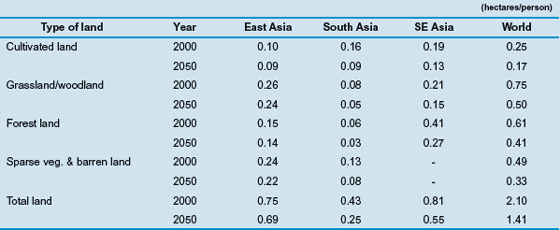
Source: Adapted from Fischer et al. (2010).
While land scarcity among different land uses is high and increasing in Asia, the capacity of the land base to meet the large forecast demands for livestock commodities is heterogeneous across the region. In Table 4 the suitability of land for the production rain-fed crops is presented by land cover class.
One-third or more of the cultivated land is already considered to be marginal in East
Asia and South Asia - the latter region having an unusually high area of cultivated land
compared to other regions in Asia and the world - and only a limited share of unprotected
grassland/woodland and forest land areas are considered to be of prime or good quality
in these regions. The prospects are somewhat brighter in Southeast Asia where there are
greater shares of unprotected grassland/woodland and forest land areas that are suitable
for crop production (Table 3). However, the conversion of these areas into cultivation for
feed or food can lead to losses of biodiversity, ecosystem services and a significant release
of greenhouse gases.
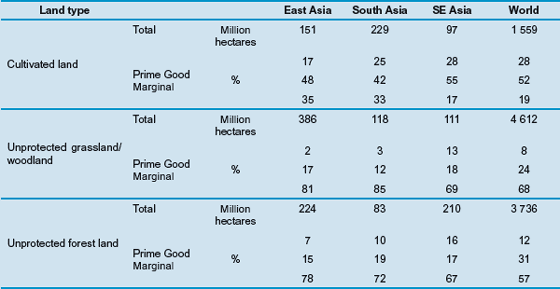
Source: Adapted from Fischer et al. (2010).
Livestock growth is expected to continue to place pressures on these land resources, as feed deficits continue to grow in the region. For example, it is estimated that there was a deficit in terms of animal feed requirements and actual consumption by animals in India in 2002-2003 of 157 million tonnes of green fodder, 44 million tonnes of dry fodder and 25 million tonnes of concentrates. This deficit is anticipated to worsen as a consequence of increase competition for land (Chacko et al. 2010).
Water scarcity
While large gains in land productivity in crop and livestock production have been delivered through productivity improvements, much of the gains have been possible due to more intensive application of non-land inputs, such as irrigated water and inorganic fertilisers, to land, i.e. a substitution of non-land inputs for land. Globally, all of the net increase
in cultivated land area can be attributed to increases in the area of irrigated land (FAO 2011b).
Agriculture is a significant user of water resources, accounting for 70 per cent of
withdrawals globally. In Southeast Asia and Southern Asia in particular, agriculture accounts
for a substantially larger share of total withdrawals (Table 5). However, prospects for
irrigation development are constrained by the faster growing demands for water in other
uses as developing countries continue to industrialize (Fischer et al. 2010).

Source: Adapted from FAO (2011b).
As shown in Table 6, the area equipped for irrigation across Asia has increased substantially, with gains of 96, 134 and 160 percent for East Asia, South Asia and Southeast Asia, respectively, with similarly large gains in irrigated land as a percentage of cultivated land. Further, as surface water sources have become depleted, the share of irrigated water from groundwater sources has grown steadily since 1961. Much of these increases in withdrawals is attributed to expanding livestock production, particularly because livestock is a much more inefficient user of water than crop production. For instance, there has been a strong increase in livestock populations and areas of fodder crops in irrigated areas of Asia for milk production (de Haan 2010).

Source: Adapted from FAO (2011b).
It is estimated that withdrawals rates that exceed 20 per cent of renewable water resources put substantial pressure on water resources, and rates that exceed 40 per cent are critical, causing serious adverse effects on ecosystem functions. As shown in Table 7, irrigation withdrawals in South Asia account for more than half of renewable water resources because large areas of cultivated land have reached or expanded beyond their potential. Overall figures give an overly optimistic impression for other regions in Asia (FAO 2011b). For example, on average China’s extraction rates are below these critical thresholds, however, there are areas in the North China Plain with excessive extraction rates. In addition to water scarcity, soil and water salinity problems have been reported in association with large irrigation schemes in Pakistan, China and India.

Source: Adapted from FAO (2011b).
Fertiliser use and yields
In addition to the use of irrigation water extractions, fertiliser use has also intensified as yields on ever scarcer land resources struggle to meet the growing demands from livestock and humans for cultivated crop outputs. As shown in Figure 1, fertiliser application rates across the world are closely linked with yields. What is striking about this figure are the extremely high rates of fertiliser application rates applied in China, which have recently exceeded the rates of all other world regions, allowing East Asia to obtain yields that are comparable or higher than most developed regions.
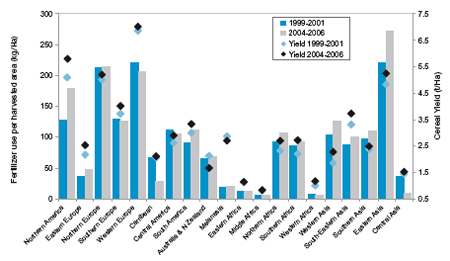
Source: Fischer et al. (2010).
Nutrient Loading
As discussed, much of the massive increase in livestock production in the Asian region has been accompanied by land intensification and geographical clustering of pig, poultry
and dairy sector operations (de Haan 2010). These structural changes, which have been
particularly rapid in large parts of Asia, have also been accompanied by a shift from
litter-based to slurry-based systems, and a decline in effective manure management as
livestock production has become increasingly less integrated with crop production (Menzi
et al. 2010). The threats from industrial dairy and piggery operations pose more serious
threats than poultry, because manure from the former are handled in liquid form and can
therefore enter waterbodies more easily(Chacko et al. 2010).
The geographic concentration of intensive production units and their disconnection of
the land base, result in nutrient waste outputs surpassing the nutritive requirements and
assimilative capacity of local surrounding land. Thus livestock waste must either undergo
treatment to remove surplus nutrients, be transported elsewhere or, more commonly,
discharged to other areas (Menzi et al. 2010). Poor manure management and its resultant
discharge to the environment has serious consequences including: water pollution;
eutrophication of surface water, groundwater and coastal marine ecosystems; emissions
of ammonia, methane and nitrous oxide; and soil pollution through accumulation of heavy
metals. These impacts in turn lead to impaired human health and loss of biodiversity,
climate change, acidification and ecosystem degradation (Menzi et al. 2010).
From a global perspective, these environmental risks associated with intensive livestock
production are greatest in East and Southeast Asia because of current high concentration
of animals, the rapid expansion of intensive monogastric production and a general lack of
well-enforced regulatory safeguards, along with limited public awareness of environmental
impacts and the absence of a tradition of recycling liquid manure to crops (Menzi et al.
2010). Indeed, waste from industrial piggery operations is the primary source of nutrient
loading affecting waterways in China, Thailand and Viet Nam, contributing from 14 to 72 per cent of nitrogen and 61 to 94 per cent of phosphorus accumulations (Reid et al. 2010).
Moreover, with increasing reliance on imported feedstuffs, the disruption of nutrient cycles,
which typifies these production systems, is increasingly shifting from local to national and
global scales, as the recycling of nutrients becomes ever more challenging for industrial
operations with little land.
These problems are particularly acute in China, which already has very
high rates of fertiliser application, especially in its eastern provinces. As shown in Figure 2,
the total nitrogen load, including nitrogen from manure and fertiliser sources, exceeds 400kg per hectare in many provinces located in the eastern part of the country (Bingsheng 2010).
The significant feed requirements of increasingly prevalent industrial livestock production
systems exert additional pressures on cultivated land, which is increasingly dependent on
huge importation of fertilisers to boost cereal production. Indeed half of fertiliser nitrogen
that is traded globally is now used to produce feed for intensive animal production systems
(Galloway et al. 2010). Consequently, livestock is not only responsible for environmental
impacts associated with the direct discharge of urine and manure, but also indirectly through
nitrates, pesticides and other chemicals used on croplands that run off into waterways
(Reid et al. 2010).
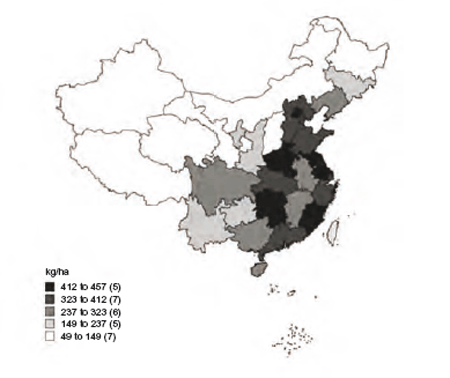
Source: Bingsheng (2010).
Greenhouse Gas (GHG) Emissions
Livestock production is the world's largest source of methane (CH4) emissions and is also responsible for release of significant nitrous oxide (N2O) and carbon dioxide (CO2) emissions. The GHG contributions vary considerably between livestock systems and regions according to animal physiology, agroclimatic conditions, quality of feed resources, manure management practices and degree of intensification. Asian livestock is estimated to emit about one-third of all livestock GHGs globally, more GHGs than any other region
in the world (Reid et al. 2010).
Enteric CH4 emissions among all ruminants are closely related to the feed regime,
particularly feed quantity and quality, and ultimately the productivity of the production
system. The fraction of feed converted to CH4 emissions generally decreases as both the
amount of feed intake and the feed quality increases (US EPA 2006a). Manure handling
and storage are significant sources of both CH4 and N2O emissions. CH4 emissions are generated by the decomposition of manure under anaerobic conditions and the quantity of emissions depends on the type of treatment or storage facility, the composition of the manure and ambient climate (US EPA 2006b).
Pig and dairy enterprises can be significant emission sources due to their handling and storage of manure in liquid/slurry systems. N2O, however, is derived from the microbial transformation of nitrogen in manure deposited on soils by grazing livestock or application on soils for the production of feed (Steinfeld et al. 2006).
Agricultural CO2 emissions are mainly derived indirectly from land use, land-use
change and forestry, due to forest clearing for pasture and feed crops and from rangeland
degradation. Approximately 20 per cent growth in both enteric and manure emissions
occurred between 2005 and 2020, with falling contributions from Organisation for Economic
Co-operation and Development (OECD) and non-EU Eastern European countries; this was
more than offset by significant emission increases in China, Latin America, Africa, South
Asia, Southeast Asia and the Near East (Smith et al. 2007).
As shown in Figure 3, there is a robust relationship between GHG emission intensity
(including all GHG emissions along the dairy food chain) and milk yields in the dairy
sector, globally. Within Asia, highly productive countries in East Asia and Southeast Asia,
including Japan, Thailand and China perform well globally with respect to their emission
intensities.
Grassland Degradation
In 2009, China and Mongolia combined had more than 500 million hectares of grasslands,
comprising 15 per cent of the world's and 84 per cent of Asia's (excluding central and west
Asia) grasslands (FAOSTAT 2012). Two-thirds of the Asian region's grassland area is
found in China alone, which has around 40 per cent of its total land devoted to grasslands.
Institutional and regulatory weakness often lead to management practices that promote
overgrazing, consequently a large share of the region's grazing lands are suffering
from degradation. Overgrazing reduces vegetation cover, exposing soils to water and
wind erosion, which decreases their capacity to retain moisture and thus contributes to
declining vegetation yields. This process of degradation oxidises soil carbon, contributing
to atmospheric CO2 emissions. An estimated 50 per cent of northern China's grasslands
were degraded to different degrees between the 1960s and 1990s (Li 1997).
Further,
overgrazing and conversion of grassland to cropland have caused a loss of 30 to 35 per cent
of total grassland soil organic carbon in China (Wang et al. 2011). Problems of overgrazing
are particularly acute in the Inner Mongolia region where numbers of small ruminants have
more than doubled in the past two decades, from around 25 million head in 1985 to over
56 million head in 2006, and in Tibet Autonomous Region of China, where the numbers of
yaks increased from 5.4 million to 6.3 million from 1995 to 2005 (Bingsheng 2010).
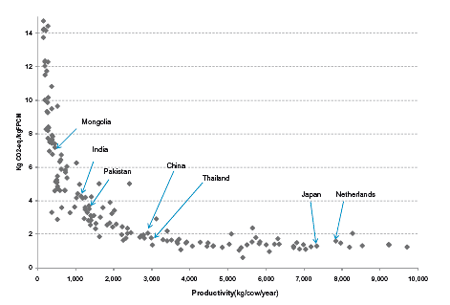
Source: FAO (2010).
Solutions and Response
While the precise management and policy solutions to the environmental issues outlined must obviously be tailored to regional and local situations and contexts, they can be generalised into three broad thematic areas including measures that: 1) improve the efficiency with which natural resources are used in the livestock production process; 2) restore degraded grasslands; and 3) reduce manure discharges from intensive animal production systems.
Improved natural resource-use efficiency
As discussed earlier, the transfer and adoption of technology have been instrumental in raising both animal yields and crop yields over the past few decades, allowing the extraction of larger quantities of animal protein from an increasingly constrained agricultural land base in the Asian region. However, many of these improvements have been made possible
through substitution by artificial inputs such as fertilisers, which may result in the replacement
of one natural resource constraint with another, e.g. scarcities of rock phosphate, fossil fuels,
clean water and biodiversity).
However, as demonstrated by the inverse relationship with
milk yields and emission intensities, intensification of the relatively unproductive traditional
dairy production systems found in less developed parts of the Asian region, may provide
a potential avenue for large GHG mitigation gains. Where access to markets and capital
are sufficient, this can be progressed through the application of science and advanced
technology in feeding and nutrition, genetics, reproduction and animal health control, to
improve feed conversion efficiency (Ugalde et al. 2008).
Nevertheless, the pursuit of improved yields and other conventional measures of
productivity will not be sufficient to raise the efficiency of many natural resources which, due to market and regulatory failures, do not enter the profit-maximising calculus of most livestock producers. For example, as shown by Hoang and Coelli (2009) in a study on
OECD agriculture, a number of countries - Australia, United States, Canada, Portugal - increased their total factor productivity between 1990 and 2003 but reduced their nutrient use efficiency at the same time. Nevertheless, the prevalence and persistence of large
gaps in efficiency with which resources are used by livestock producers indicate that, if backstopped by appropriate resource pricing and regulatory incentives, the transfer of technology and knowledge from the region's most to least efficient producers could allow the sector to reap a 'double dividend' by simultaneously enhancing producer profits and environmental outcomes.
Grassland restoration
As discussed, grassland degradation is a source of CO2 emissions and biodiversity loss. It also reduces long-term productivity and economic returns and reduces the capacity of
landholders to adapt to climate change. Grassland restoration and enhancement have
the potential to address each of these issues and thus deliver mitigation, adaptation and
producer (livelihood) benefits. Further, given the significant potential for grassland restoration
and enhancement to sequester carbon, there is great potential to support these actions
with mitigation finance accessed through carbon markets.
As discussed in Wang et al. (2011), techniques for reversing soil organic carbon
losses, such as the management of grazing intensities (Conant and Paustian 2002) and
measures that raise the primary productivity of grasslands (and therefore plant litter returns
to soil) such as the introduction of improved pastures (Conant 2010) are well understood
and therefore rapidly deployable strategies. Wang et al. (2011) estimate that improved
grazing and conversion of cropland to cultivated pasture would sequester 0.24Pg C per year
equivalent to 16 percent of fossil CO2 emissions in China in 2006, which is larger than the
sequestration potential of no-till and residue management (0.025-0.037 Pg C per year) and
larger than the 0.165 Pg C per year potential identified for the technical sequestration potential
of afforestation in China. However, presently, this vast potential remains untapped, mainly
due to the absence of (1) carbon accounting methodology that is affordable but sufficiently
accurate to support credit creation and trade in carbon markets and (2) an international
programme (e.g. UN REDD, for forestry) to overcome these and other barriers and to
coordinate R&D and implementation.
Reduced discharge from intensive animal production systems
Technical options exist to recover nutrients and energy from manure but the economics of their adoption vary greatly with production systems and access to land, from net costs to net benefits. A big obstacle is that many parts of the Asia-Pacific region's manure is treated as waste rather than as a valuable source of crop nutrients. Consequently, only a fraction of excreted nutrients is managed properly in the region (Menzi et al. 2010).
Further, regulatory options are also well understood such as: restriction zones around
sensitive areas; the application of waste discharge standards; the application of economic
incentives for proper waste management; and the training of owners/employees on proper
waste management. Within the region these options are either absent or poorly enforced.
For example, due to lack of location restrictions, half of the pig farms in Jianxi Province,
China, were found to be located less than one kilometre from residential areas (Bingsheng
2010). Further, government standards for waste emissions from livestock farms along
with emission tax instruments were introduced in China in 2003, however, as yet, these
standards have not been enforced and neither have any waste disposal fees been collected
(Bingsheng 2010).
Given these obstacles, a reduced discharge programme may be more effective if it
were driven by the private sector through voluntary commitments but supported by public
policies. To lower adoption costs, policies need to ensure that livestock densities within
any particular area are kept within the absorptive capacity of available land. Further, there
is a need to better understand the reasons for industry agglomeration and the policy tools
which can balance geographic distribution. Technical and policy guidelines need to be
developed, technologies transferred and capacities developed.
References
Bingsheng, K. 2010. China: the East-West dichotomy. In P. Gerber et al., eds. Livestock in a changing landscape: experiences and regional perspectives, volume 2, p55 Island Press.
Chacko, C. et al. 2010. India: growth, efficiency gains, and social concerns. In P. Gerber et al., eds. Livestock in a changing landscape: experiences and regional perspectives, volume 2, p96. Island Press.
Conant, R. & Paustian, K. 2002. Potential soil carbon sequestration in overgrazed grassland ecosystems. Global Biogeochemical Cycles, 1143.
Conant, R. 2010. Challenges and opportunities for carbon sequestration in grassland systems: A technical report on grassland management and climate change mitigation. Integrated Crop Management Vol. 9. Prepared for the Plant Production and Protection
Division, FAO.
de Haan, C., Gerber, P. & Opio, C. 2010. Structural change in the livestock sector. In H. Steinfeld et al., eds. Livestock in a changing landscape: drivers, consequences, and responses, volume 1, p.35. Island Press.
Food and Agriculture Organization of the United Nations (FAO). 2010. Greenhouse gas emissions from the dairy sector: a life cycle analysis. Unpublished FAO report; 2010.
FAO. 2011a. Looking ahead in world food and agriculture: perspectives to 2050. Rome, FAO.
FAO. 2011b. The state of the world's land and water resources for food and agriculture: managing systems at risk. Rome, FAO.
FAOSTAT. 2012. faostat.fao.org, accessed 7 August 2012.
Fischer, G., Hizsnik E., Prieler S. & Wiberg, D. 2010. Scarcity and abundance of land resources: competing uses and the shrinking resource base. SOLAW Background Thematic Report – TR02, FAO, 2010.
Galloway, J., Dentener, F., Burke, M., Dumont, E., Bouwman, A., Kohn, R., Mooney, H., Seitzinger, S. & Kroeze, C. 2010. The impact of animal production systems on the nitrogen cycle. In H. Steinfeld et al., eds. Livestock in a changing landscape: drivers, consequences, and responses, volume 1, p.83. Island Press.
Huang, V-N, & Coelli, T. 2009. Measurement of agricultural total factor productivity growth incorporating environmental factors: a nutrients balance approach. Centre for Efficiency and Productivity Analysis, working paper series No. WP03/2009, University
of Queensland, Australia.
Li, B. 1997. Degradation of northern temperate grasslands and protection strategies in China. Agric. Sci. China, 30:1-10.
Menzi, H., Oenema, O., Burton, C., Shipin, O., Gerber, P., Robinson, T. & Franceschini G. 2010. Impacts of intensive livestock production and manure management. In H. Steinfeld et al., eds. Livestock in a changing landscape: drivers, consequences, and responses, volume 1, p.139. Island Press.
Pingali, P. & McCullough, E. 2010. Drivers of change in global agriculture and livestock systems. In H. Steinfeld et al., eds. Livestock in a changing landscape: drivers, consequences, and responses, volume 1, p5. Island Press.
Reid, R., Bedelian, C., Said, M., Kruska, R., Mauricio, R., Castel, V., Olson, J. & Thornton, P. 2010. Global livestock impacts on biodiversity. In H. Steinfeld et al., eds. Livestock in a changing landscape: drivers, consequences, and responses, volume 1, p111. Island Press.
Smith, P., Martino, D., Cai, Z., Gwary, D., Janzen, H., Kumar, P., McCarl, B., Ogle, S., O’Mara, F., Rice, C., Scholes, B. & Sirotenko, O. 2007. Agriculture. In B. Metz et al., eds. Climate change 2007: mitigation. Contribution of Working Group III to the Fourth Assessment Report of the Intergovernmental Panel on Climate Change. Cambridge, United Kingdom and New York, NY, USA, Cambridge University Press.
Steinfeld, H., Gerber, P., Wassenaar, T., Castel, V., Rosales, M. & De Haan, C. 2006. Livestock’s long shadow: environmental issues and options. Rome, FAO.
Ugalde, D, van Vliet, J., McGregor, A. & Slattery, B. 2008. Policy options to manage greenhouse gas emissions from the livestock sector: an Australian perspective. Australian Journal of Experimental Agriculture (Greenhouse Gases and Animal
Agriculture), 48:vii-xii.
United States Environmental Protection Agency (US EPA). 2006a. Global mitigation of non-CO2 greenhouse gases. EPA 430-R-06-005. Washington DC, US EPA.
US EPA. 2006b. Global anthropogenic non-CO2 greenhouse gas emissions: 1990–2020. EPA 430-R-06-003. Washington DC, US EPA. 2006.
Wang, S., Wilkes, A., Zhang, Z., Chang, X., Lang, R., Wang, Y. & Niu, H. 2011. Management and land use change effects on soil carbon in northern China’s grasslands: a synthesis. Agriculture, Ecosystems and Environment, 142:329-340.
Further ReadingYou can view the previous articles from this proceedings:Feed and Fodder Challenges for Asia and the Pacific Hog Farming in Transition: The Case of China |
March 2013






